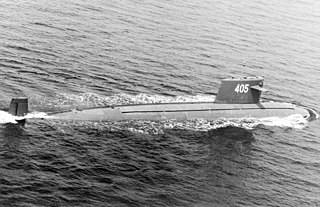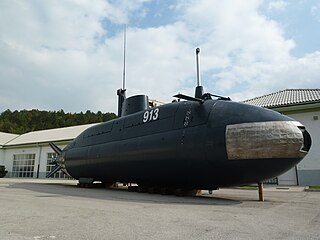
The Type 212A is a class of diesel-electric submarine developed by Howaldtswerke-Deutsche Werft AG (HDW) for the German Navy, and the Italian Navy where it is known as the Todaro class. It features diesel propulsion and an additional air-independent propulsion (AIP) system using Siemens proton-exchange membrane (PEM) compressed hydrogen fuel cells. The submarines can operate at high speed on diesel power or switch to the AIP system for silent slow cruising, staying submerged for up to three weeks with little exhaust heat. The system is also said to be vibration-free and virtually undetectable.

Tench-class submarines were a type of submarine built for the United States Navy (USN) between 1944 and 1951. They were an improvement over the Gato and Balao classes, only about 35 to 40 tons larger, but more strongly built and with a slightly improved internal layout. One of the ballast tanks was converted to carry fuel, increasing range from 11,000 nautical miles to 16,000 nautical miles. This improvement was also made on some boats of the previous two classes. Further improvements were made beginning with SS-435, which are sometimes referred to as the Corsair class. Initial plans called for 80 to be built, but 51 were cancelled in 1944 and 1945 when it became apparent that they would not be needed to defeat Japan. The remaining 29 were commissioned between October 1944 (Tench) and February 1951 (Grenadier). The last submarine of the Tench class, as well as the last submarine which served during World War II, remaining in service with the U.S. Navy was USS Tigrone (AGSS-419) which was decommissioned on 27 June 1975.

A diver propulsion vehicle (DPV), also known as an underwater propulsion vehicle, sea scooter, underwater scooter, or swimmer delivery vehicle (SDV) by armed forces, is an item of diving equipment used by scuba divers to increase range underwater. Range is restricted by the amount of breathing gas that can be carried, the rate at which that breathing gas is consumed, and the battery power of the DPV. Time limits imposed on the diver by decompression requirements may also limit safe range in practice. DPVs have recreational, scientific and military applications.

A midget submarine is any submarine under 150 tons, typically operated by a crew of one or two but sometimes up to six or nine, with little or no on-board living accommodation. They normally work with mother ships, from which they are launched and recovered and which provide living accommodation for the crew and support staff.

The SEAL Delivery Vehicle (SDV) is a crewed submersible and a type of swimmer delivery vehicle used to deliver United States Navy SEALs and their equipment for special operations missions. It is operated by SEAL Delivery Vehicle Teams.

Human torpedoes or manned torpedoes are a type of diver propulsion vehicle on which the diver rides, generally in a seated position behind a fairing. They were used as secret naval weapons in World War II. The basic concept is still in use.

The Pakistan Navy (PN) is the uniform naval warfare branch of the Pakistan Armed Forces. The President of Pakistan is the Supreme Commander of the Navy. The Chief of the Naval Staff, a four-star admiral commands the navy. The Pakistan Navy operates on the coastline of Pakistan in the Arabian Sea and Gulf of Oman. It was established in August 1947, following the independence of Pakistan from the United Kingdom.

The Type 091 is a first-generation nuclear-powered attack submarine produced by China. It was the People Liberation Army Navy's (PLAN) first nuclear submarine, and the first indigenously produced nuclear attack submarine in Asia.

The Advanced SEAL Delivery System (ASDS) was a midget submarine operated by the United States Navy and United States Special Operations Command. It provided stealthy submerged transportation for United States Navy SEALs from the decks of nuclear submarines for use as an insertion platform for covert and clandestine special operations missions. The ASDS was canceled in 2009 due to cost overruns and reliability issues, after the prototype was destroyed in a fire in 2008. As of 2019, the Navy plans to replace the ASDS with the Dry Combat Submersible, a similar midget submarine being developed by Lockheed Martin.

The Shchuka-class submarines, also referred to as Sh or Shch-class submarines, were a medium-sized class of Soviet submarines, built in large numbers and used during World War II. "Shchuka" is Russian for pike. Of this class, only two submarines entered service after 1945, although they were launched before the war.

The Pakistan Navy Special Service Group is the special operations force tasked with the conducting the small-unit based military operations in all environmental formats of the sea, air, and land by adopting to the tactics of the unconventional warfare.

The Cosmos-class submarine, officially Cos.Mo.S MG-110 locally designated as X-Craft, are the class of midget submarines designed by the Italian firm Cos.Mo.S, in Karachi Naval Dockyard in Karachi, Sindh, Pakistan.

The upcoming Columbia-class nuclear-powered ballistic missile submarines of the United States Navy are designed to replace the Ohio class. Construction of the first vessel began on 1 October 2020. She is scheduled to enter service in 2031.
CosMoS CE2F were a series of swimmer delivery vehicles (SDV) built by M/s Cos.Mo.S Spa. which was based in Livorno, Italy.

The Una-class submarine was a class of six midget submarines built for the Yugoslav Navy at the Brodogradilište specijalnih objekata during the 1980s. They were designed with the purpose of laying small minefields and transporting naval special forces, with or without their submersibles, in shallow waters that were inaccessible for larger submarines. Due to their mission profile that called for a small design as well as the need to stay undetected, they lacked torpedo armament and a generator for battery recharging.

The R-2 Mala is a class of swimmer delivery vehicles (SDVs) built for the Yugoslav, and later on, Croatian Navy. The two man wet SDVs are used for transporting naval commandos into hostile waters where they would perform sabotage on enemy warships and coastal installations. Weapons at their disposal included limpet mines.
Vice-Admiral S. Tauqir H. Naqvi (HI, SBt, is a retired three-star rank admiral in the Pakistan Navy, politician, and a diplomat who served as the Chairman of the Pakistan National Shipping Corporation from 2000 until 2007, the longest serving chairman in the national flag carrier's history.
Cos.Mo.S, officially Costruzione Motoscafi Sottomarini s.a.s, was an Italian submarine and submersible manufacturer.
Drass, or DRASS, is an Italian manufacturing company headquartered in Livorno, whose best known for their range of midget submarine and swimmer delivery vehicle. They also have a line of hyperbaric chambers for diver decompression.














